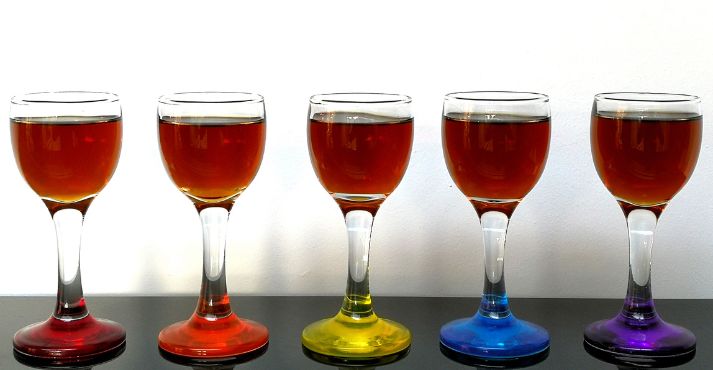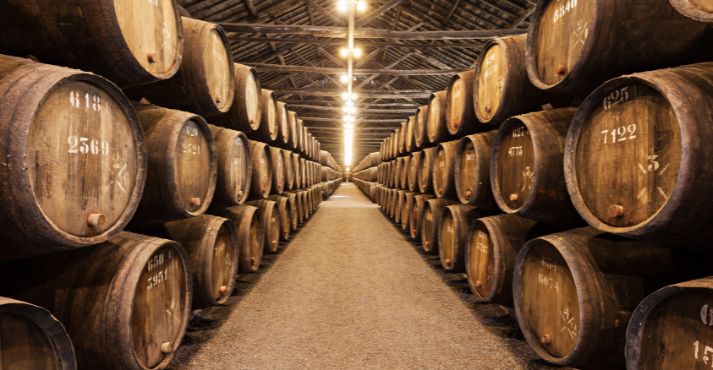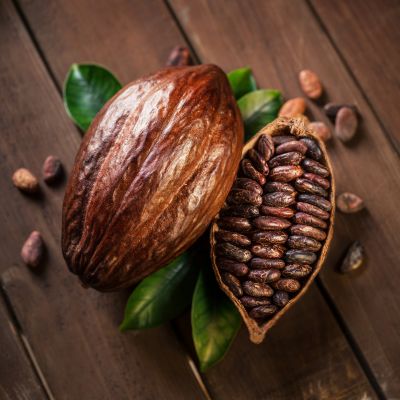Greetings, wine lovers! Today, we embark on a journey into the captivating realm of Sherry wine—a beverage that transcends mere consumption, encapsulating centuries of Spanish viticultural traditions.
What sets Sherry apart? It’s not just a libation; it’s a narrative rooted in history and crafted with meticulous care. Imagine sun-drenched Spanish vineyards contributing to the essence of every bottle.
As we delve into the nuances of Sherry, we’re not merely discussing a beverage; we’re unraveling a chapter of Spanish heritage within each pour. Join us as we explore the allure of Sherry wine and acquaint ourselves with the diverse types that define its prominence in enology.
What is Sherry Wine?
Sherry wine is quite a unique gem in the world of natural wines, carrying a rich history of flavors. Let’s explore the essence of Sherry by diving into what it is and where it comes from.
Defining Sherry Wine
A Special Kind of Wine
Sherry isn’t your typical wine; it’s fortified, making it stand out in a crowd of wines. The process it goes through creates a mix of flavors that dance on your taste buds.
Roots in Spanish Winemaking Tradition
The story of Sherry goes way back, rooted in the vibrant traditions of Spanish winemaking. Dating back to the 9th century, Sherry has been nurtured in the sun-soaked vineyards of Jerez de la Frontera, shaping its unique character.
Connection to Andalusian Wines
Understanding Sherry means taking a trip through the history of Andalusian wines. The region’s land, weather, and types of grapes all play a part in creating the magic that is Sherry wine.
Fortification Techniques: Crafting Sherry
A big part of what makes Sherry unique is how it’s made. A balanced and rich taste emerges by fortifying the wine with spirits, defining what Sherry is all about.
Tracing Sherry’s Roots
Exploring the Definition and Origin
Tracing Sherry’s roots is like journeying through time and the land it comes from. It’s a story of passion, craftsmanship, and a commitment to preserving age-old winemaking traditions.
Embracing the Terroir: Sherry’s Essence
As we dig into the details of Sherry’s origin, we discover a deep connection between the wine and the land it calls home. Every sip of Sherry is like a taste of the essence of Spanish winemaking.
Historical References: Sherry’s Story
Referencing historical documents, such as the works of Alfonso X, “El Sabio,” from the 13th century, gives us a detailed look at Sherry’s evolution. These references guide us through the milestones and transformations that have shaped Sherry into today’s celebrated wine.
Sherry Production Process
Let’s take a closer look at how Sherry is made. The process is like crafting a unique piece of art – it involves a few special steps that give Sherry its distinctive taste.
Making Sherry: A Simple Beginning
It starts with picking specific grapes from sunny Jerez de la Frontera vineyards. Grapes like Palomino, Pedro Ximénez, and Moscatel bring their flavors.
Fortification: Adding a Boost
Next, we add grape spirits to the wine. This makes it more robust and gives Sherry its unique character. It’s like finding the right balance in a recipe.
How Sherry is Made
Solera Aging: Time Matters
Sherry ages in a unique way called the solera system. Imagine barrels stacked on top of each other like a pyramid.
The oldest wine is at the bottom, and new wine is added to the top. This slow blending over time is like creating a delicious blend of different ages.
Biological and Oxidative Aging: Two Roads to Flavor
As Sherry ages, it goes through two processes – biological and oxidative. In some types, a layer of yeast forms over the wine, giving it a unique taste. In others, the aging happens without the yeast, making the Sherry richer and darker.
Bottling: Ready for Enjoyment
After patiently waiting for the perfect taste, Sherry is ready to be bottled. Each bottle tells a story of the land, the fortification process, and the unique aging system. It’s like capturing the essence of time in a bottle.
5 Types of Sherry Wine: A Comprehensive Exploration

Explore Sherry Wine’s varied and exciting world, where each type offers a different and enjoyable taste.
1. Fino Sherry: Unveiling the Dry Elegance
Understanding the Essence of Fino Sherry
Fino Sherry, the embodiment of dry elegance, invites enthusiasts into a world of nuanced flavors and meticulous craftsmanship. The first characteristic that catches the eye is its pale straw-like color, offering a visual prelude to the refreshing taste that awaits.
Flavor Profile and Characteristics
On the nose, Fino Sherry captivates with subtle almond notes, a signature aroma that sets it apart. The palate is treated to a crisp and refreshing experience, making it an ideal choice, especially on warm Andalusian afternoons.
The secret to its unique characteristics lies in the protection from oxidation, thanks to the flor layer covering the wine during aging.
Production Specifics: Fortification and Solera System
The production of Fino Sherry involves a careful fortification process, where grape spirits are added to the base wine.
This not only boosts the alcohol content but also imparts a unique character to the wine. The fortification process for Fino is a precise task, demanding accuracy to find the ideal balance and bring out the subtle details in the wine.
Fino Sherry matures in the solera system, a traditional aging method that involves stacking barrels in a tiered system.
The oldest wine is at the bottom, and newer wines are added to the top. This gradual blending of vintages ensures a consistent and refined taste, contributing to the overall elegance of Fino Sherry.
Ideal Serving Conditions: Chilled Elegance and Perfect Pairings
To fully appreciate Fino Sherry, serve it chilled, ideally at 7-10°C (45-50°F). This enhances its refreshing qualities, making it a perfect companion for various tapas, nuts, olives, or seafood.
The versatility of Fino Sherry in pairing with different dishes adds to its allure, creating a delightful harmony of flavors.
2. Oloroso Sherry: Diving into Richness and Complexity
Exploring the Intensity of Oloroso Sherry
With its deep amber hue and pronounced nutty aromas, Oloroso Sherry invites connoisseurs to dive into a world of richness and complexity.
Unlike Fino, Oloroso undergoes exposure to oxygen during its extended aging process, fostering intense flavors and contributing to its full-bodied and velvety texture.
Flavor Profile and Characteristics
The pronounced nutty aromas on the nose, with notes of walnuts, hazelnuts, and a subtle hint of toffee, create an indulgent and memorable sensory experience.
On the palate, Oloroso impresses with its full-bodied and velvety texture, delivering a symphony of rich, dried fruit and spicy notes.
The extended aging, often in the solera system, allows Oloroso to develop a deep and complex character that distinguishes it in the world of Sherry.
Ideal Serving Conditions: Room Temperature Enjoyment and Pairing Power
Oloroso Sherry is traditionally served at room temperature or slightly chilled, depending on personal preference. This allows the full-bodied and robust qualities of Oloroso to shine, creating a warming and satisfying experience.
Regarding pairing, Oloroso’s versatility stands out, making it an ideal companion to aged cheeses, cured meats, and hearty stews.
3. Amontillado Sherry: A Versatile Expression
Exploring the Unique Characteristics of Amontillado Sherry
Amontillado Sherry is a testament to versatility, undergoing biological and oxidative aging processes. This dual aging imparts various characteristics that make Amontillado a fascinating and adaptable choice for Sherry enthusiasts.
Biological and Oxidative Aging: A Dual Journey
The unique journey of Amontillado begins with biological aging under the protective layer of flor, similar to Fino Sherry. This stage brings about the crisp and refreshing qualities associated with flor-aged Sherries.
However, the journey continues. Amontillado continues its evolution through oxidative aging, where the protective flor layer is intentionally weakened or naturally diminishes, exposing the wine to oxygen.
This dual aging process produces a Sherry with a complex and layered flavor profile, combining the best of both worlds.
4. Palo Cortado Sherry: A Rare Gem with Complex Aging
Unraveling the Rarity and Complexity of Palo Cortado
Palo Cortado Sherry is a rare gem celebrated for its intricate aging process and distinct flavors. This Sherry type often falls into a category of its own, showcasing characteristics that make it a sought-after choice for those who appreciate rarity and complexity.
Aging Process: Intricate Nuances

The aging process of Palo Cortado begins similarly to Fino and Amontillado, under the protective layer of flor.
However, the flor layer naturally diminishes at a particular stage, exposing the wine to oxidative aging. What sets Palo Cortado apart is the intentional decision to fortify the wine to a higher alcohol level, steering it away from the typical path of Amontillado.
This unique approach results in a Sherry with a distinct and concentrated flavor profile, combining the elegance of flor-aged Sherries with the richness of oxidative aging.
5. Pedro Ximénez (PX) Sherry: Savoring Sweet Elegance
Exploring the Sweet Elegance of Pedro Ximénez Sherry
Pedro Ximénez (PX) Sherry offers a departure from the dry profiles of Fino and Oloroso, inviting enthusiasts to savor the sweet elegance imparted by the Pedro Ximénez grape variety.
With its unique grape character, PX Sherry finds a place in both dry and sweet Sherry styles, creating a diverse and delightful experience.
Grape Variety and Sweetness: A Perfect Pairing
The sweetness of Pedro Ximénez Sherry is a result of the grape variety itself. The PX grape is known for its high sugar content, making it an ideal choice for producing sweet wines.
This sweetness is beautifully balanced in PX Sherry, creating an elegant and harmonious profile that captivates the palate.
Versatility in Styles: From Dry to Sweet Sherry
What makes PX Sherry intriguing is its versatility. While it can be used to create intensely sweet Sherry styles, it also finds a place in the production of dry Sherries, contributing to the complexity and depth of the blend.
This versatility allows PX Sherry to be a standalone delight and a valuable component in creating diverse Sherry styles.
Conclusion
In our final stop on the Sherry adventure, we’ve uncovered the rich world of this beloved wine. From the nutty tones of Amontillado to the sweet allure of Pedro Ximénez, each type of Sherry tells a unique tale—a tale of culture, tradition, and changing tastes.
As we raise our glasses to say goodbye, let’s appreciate Sherry’s many sides. It’s not just about the grape; it’s a celebration of craftsmanship, culture, and the ever-changing flavors that make this wine timeless.
Here’s to the diversity in every sip and the cultural journey in each glass! Until our next wine adventure, may your glasses be filled with the richness of Sherry.












